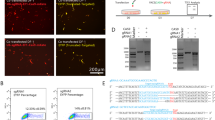Abstract
Differential expression of transgenes in transgenic animals is one of the main drawbacks of pronuclear injection. To overwhelm this issue, the genetic constructs are equipped with insulators. In this study, the consensus of exerting chicken hypersensitive site-4 (cHS4) insulator was examined on the shield of phosphoglycerate kinase-1 (Pgk-1) promoter from the surrounding chromatin in transgenic mice. The PGK-EGFP cassette was flanked by insertion of three copies of the cHS4 insulators. Mouse zygotes’ microinjection by the constructed cassette was resulted in the birth of nine transgenic founders (F0). Copy-number-dependent expression of the EGFP was investigated in the transgenic F1 offspring by fluorometry and real-time PCR. They showed no correlation between the expression level of transgene and gene copy number among the transgenic lines. Moreover, dissection of the EGFP-expressing mice revealed heterogeneous expression of the EGFP in the different organs. In conclusion, for the first time, these findings indicated that the cHS4 sequence is not a perfect insulator to fully protect the Pgk-1 promoter from the side effects of integration site in transgenic mice and it needs probably to some additional elements of the cHS4 locus to reach this goal.




Similar content being viewed by others
References
Aker M, Tubb J, Groth AC, Bukovsky AA, Bell AC, Felsenfeld G, Kiem HP, Stamatoyannopoulos G, Emery DW (2007) Extended core sequences from the cHS4 insulator are necessary for protecting retroviral vectors from silencing position effects. Hum Gene Ther 18:333–343
Chung JH, Whiteley M, Felsenfeld G (1993) A 5′ element of the chicken beta-globin domain serves as an insulator in human erythroid cells and protects against position effect in Drosophila. Cell 74:505–514
Emery DW, Yannaki E, Tubb J, Stamatoyannopoulos G (2000) A chromatin insulator protects retrovirus vectors from chromosomal position effects. Proc Natl Acad Sci USA 97:9150–9155
Emery DW, Aker M, Stamatoyannopoulos G (2003) Chromatin insulators and position effects. New Compr Biochem 38:381–395
Frazar TF, Weisbein JL, Anderson SM, Cline AP, Garrett LJ, Felsenfeld G, Gallagher PG, Bodine DM (2003) Variegated expression from the murine band 3 (AE1) promoter in transgenic mice is associated with mRNA transcript initiation at upstream start sites and can be suppressed by the addition of the chicken beta-globin 5′ HS4 insulator element. Mol Cell Biol 23:4753–4763
Giraldo P, Rival-Gervier S, Houdebine LM, Montoliu L (2003) The potential benefits of insulators on heterologous constructs in transgenic animals. Transgenic Res 12:751–755
Grajevskaja V, Balciuniene J, Balciunas D (2013) Chicken β-globin insulators fail to shield the nkx2.5 promoter from integration site effects in zebrafish. Mol Genet Genom 288:717–725
Hamaguchi I, Woods NB, Panagopoulos I, Andersson E, Mikkola H, Fahlman C, Zufferey R, Carlsson L, Trono D, Karlsson S (2000) Lentivirus vector gene expression during ES cell-derived hematopoietic development in vitro. J Virol 74:10778–10784
Haruyama N, Cho A, Kulkarni AB (2009) Overview: engineering transgenic constructs and mice. Curr Protoc Cell Biol. https://doi.org/10.1002/0471143030.cb1910s42
Hickman-Davis JM, Davis IC (2006) Transgenic mice. Paediatr Respir Rev 7:49–53
Kingston RE, Chen CA, Rose JK (2003) Calcium phosphate transfection. Curr Protoc Mol Biol. https://doi.org/10.1002/0471142727.mb0901s63
Martin DI, Whitelaw E (1996) The vagaries of variegating transgenes. BioEssays 18:919–923
McBurney MW, Staines WA, Boekelheide K, Parry D, Jardine K, Pickavance L (1994) Murine PGK-1 promoter drives widespread but not uniform expression in transgenic mice. Dev Dyn 200:278–293
Moltó E, Vicente-García C, Fernández A, Montoliu L (2011) Genomic insulators in transgenic animals. In: Brakebusch C, Pihlajaniemi T (eds) Mouse as a model organism. Springer, Dordrecht, pp 1–10
Pikaart MJ, Recillas-Targa F, Felsenfeld G (1998) Loss of transcriptional activity of a transgene is accompanied by DNA methylation and histone deacetylation and is prevented by insulators. Genes Dev 12:2852–2862
Potts W, Tucker D, Wood H, Martin C (2000) Chicken beta-globin 5′ HS4 insulators function to reduce variability in transgenic founder mice. Biochem Biophys Res Commun 273:1015–1018
Recillas-Targa F, Valadez-Graham V, Farrell CM (2004) Prospects and implications of using chromatin insulators in gene therapy and transgenesis. BioEssays 26:796–807
Rincón-Arano H, Furlan-Magaril M, Recillas-Targa F (2007) Protection against telomeric position effects by the chicken cHS4 beta-globin insulator. Proc Natl Acad Sci USA 104:14044–14049
Rivella S, Callegari JA, May C, Tan CW, Sadelain M (2000) The cHS4 insulator increases the probability of retroviral expression at random chromosomal integration sites. J Virol 74:4679–4687
Taboit-Dameron F, Malassagne B, Viglietta C, Puissant C, Leroux-Coyau M, Chéreau C, Attal J, Weill B, Houdebine LM (1999) Association of the 5′ HS4 sequence of the chicken beta-globin locus control region with human EF1 alpha gene promoter induces ubiquitous and high expression of human CD55 and CD59 cDNAs in transgenic rabbits. Transgenic Res 8:223–235
Wang Y, DeMayo FJ, Tsai SY, O’Malley BW (1997) Ligand-inducible and liver-specific target gene expression in transgenic mice. Nat Biotechnol 15:239–243
Whitelaw CBA, Springbett AJ, Webster J, Clark J (1993) The majority of G0 transgenic mice are derived from mosaic embryos. Transgenic Res 2:29–32
Wilson C, Bellen HJ, Gehring WJ (1990) Position effects on eukaryotic gene expression. Annu Rev Cell Biol 6:679–714
Yannaki E, Tubb J, Aker M, Stamatoyannopoulos G, Emery DW (2002) Topological constraints governing the use of the chicken HS4 chromatin insulator in oncoretrovirus vectors. Mol Ther 5:589–598
Acknowledgements
The research was funded by the Iran National Science Foundation (INSF) (Grant Number 91001148). The authors thank the National Institute of Genetic Engineering and Biotechnology for instrumental supports.
Author information
Authors and Affiliations
Corresponding author
Ethics declarations
Conflict of interest
The authors declare no conflict of interest.
Rights and permissions
About this article
Cite this article
Farzaneh, F., Mirzapoor, Z., Jahangirian, E. et al. The chicken hypersensitive site-4 insulator cannot fully shield the murine phosphoglycerate kinase-1 promoter from integration site effects in transgenic mice. 3 Biotech 9, 255 (2019). https://doi.org/10.1007/s13205-019-1786-5
Received:
Accepted:
Published:
DOI: https://doi.org/10.1007/s13205-019-1786-5




